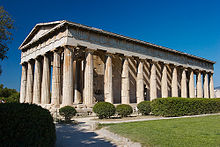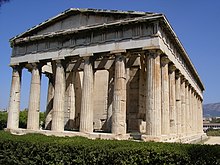Temple of Hephaestus
The Temple of Hephaestus ( ancient Greek Ἡφαιστεῖον , hence Hephaisteion ) in the center of Athens is one of the best preserved Greek temples and is mostly built from Pentelic marble .
The temple is also known under the name Theseion or Theseum , as it was believed in Byzantine times that the bones of the legendary Greek hero Theseus were buried here. Based on building inscriptions and numerous finds from the metalworking industry in the vicinity, the temple could be assigned to Hephaestus , the god of blacksmithing .
Building history
The construction of the temple began around 449 BC. Started, but the building progress from west to east dragged on. Around 430 BC The temple was largely completed, only the covering and the cult image group were still missing. Both could only be used during the Peace of Nicias between 421 and 415 BC. To be tackled. 415 BC The temple was probably dedicated. It was located on what was then the western city limits of Athens.
At that time there were many foundries and metalworking trades in this district . That is why it was consecrated to Hephaestus, the god of the metal artists at that time - the blacksmiths - (today the blacksmiths ) and their metal workers. Hephaestus was “responsible” for the entire artistic spectrum of metalworking, including the manufacture of jewelry , weapons , sacred rituals and profane everyday objects.
The temple stands on a small hill on the western edge of the agora , the Kolonos Agoraios.
Building description
Exterior construction
The temple rose on a three-tiered base, the Krepis . The lowest step was made of limestone, while the rest of the visible architecture was made of Pentelic and Parian marble. This is unusual, since the entire crepe was usually formed from one material and thus clearly stood out from the last layer of the foundation, the euthyntery , which was already visible in the upper part . The actual temple rose on the approximately 1.06 meter high substructure.
It is a circular hall temple, a peripteros , Doric order, 13.71 meters wide and 31.78 meters long, with six columns on the fronts and 13 columns on the long sides. The lower column diameter was 1.02 meters, the column height reached 5.71 meters. The center distance of the columns was 2.59 meters, the intercolumnium , the clear distance between the columns, was consequently 1.57 meters. The corner yokes show a simple contraction . Above it rose the rather heavily proportioned entablature made of Doric architrave and triglyph metope frieze with a height of 2.02 meters .
Only on the eastern front and on the adjoining first two yokes of the long sides were the metopes decorated with sculptures and made of Parian marble, while the other metopes were inserted as simple smooth marble slabs left white. The metopes on the east side depict scenes from the saga of Heracles , while the metopes on the long sides depict scenes from the life of the local hero Theseus. The latter in particular led to the interpretation of the building as a Theseion, a temple dedicated to Theseus. The sculpted metopes were backed with a deep blue, the metopes in contrasting red.
Above the triglyphone followed the Doric geison with its usual Mutulus plates. Like the adjoining Sima , it was made of Parian marble. The Sima had lion's head gargoyles on the sides of the eaves between painted palmette friezes. The pediment triangles following on the fronts were filled with figures made of Parian marble. During subsequent excavations in the 20th century, remains of these gable figures were found, which showed the battle of the Lapiths against the Centaur in the east gable, and further mythical battles in the west gable. Akrotere adorned the ridge: a floating Nike crowned the east side, a fleeing female figure, stylistically from the era of the rich style around 420 BC. Is to be assigned to the west gable.
The cella , the room containing the cult image, was integrated into this ring hall . Following the principles of Doric temple construction, the outer walls of the cell were aligned with the column axes. The resulting passageways, the ptera , were one yoke deep on the long sides, two yokes deep on the east side and one and a half yoke deep on the west side. The walkways were covered with a coffered ceiling made of Parian marble. The emphasis on the eastern porch with its particular depth can be interpreted as an element of Ionic architecture that has found its way into a Doric temple here.
The eastern vestibule had other special features. An Ionic frieze was placed over the architrave connecting the ante of the pronaos . However, this did not end at the antenna corners, as was to be expected, but, like the associated architrave, was extended beyond the side ptera and continued on the inside of the entablature of the vestibule. Above the elongated pronaos architrave it bears figurative scenes - groups of gods as spectators of mythical fights - while it continues on the remaining three sides of the vestibule as a smooth blue ribbon. This two bays deep vestibule is clearly separated from the rest of the building, from the side ptera of the ring hall, as an independent one, which is unique in this form. A figurative frieze depicting a centauromachy was also attached above the architrave of the rear opisthodom , but ends there, as expected, above the ante. Both Ionic friezes were framed by Ionic ovarian rods at the top and bottom, and the foot of the cella also had such an Ionic frieze. The accumulation of ionic elements in this otherwise strictly Doric building is remarkable.
inner space
The eastern vestibule, which was extended to two bays, resulted in a reduction in the length of the cella, which made it more compact overall. It is believed that this was a subsequent change in the plan, which served the purpose of aligning the cell proportions with those of the Parthenon . As with this one, a column position of 4 × 7 columns was inserted in the cella. At the Hephaisteion, the side columns had to be moved strongly towards the walls in order to leave enough space for the group of cult images set up in front of the surrounding rear column position. As on the Parthenon, the inner column position was Doric and two-storey in order to achieve the necessary height for the ceiling construction with reduced column diameters. Because the height of the columns in Greek architecture was dependent on the lower diameter of the columns and could only increase with this. The interior walls of the cella were roughened so that wall paintings could be attached. Nothing of these paintings has survived. The group of cult images with Hephaestus and Athena handed down from Pausanias was, according to the accounting documents, between 421 BC. BC and 415 BC Created and - almost 30 years after the start of construction - erected in the temple. It probably came from the hand of Alkamenes , but there is no proof of this.
Construction and design
The basis for the development of proportions at this temple seems to have been the middle step of the crepe. At 32.51 meters, it was one hundred feet long and 14.45 meters wide. The ratio of width to length was therefore 4: 9, which corresponds to the proportion system of the Parthenon. The height up to and including the geison had this proportion in relation to the width, which in its inversion also recurs in the ratio of the column height to the yoke at 9: 4. All of this seems to be borrowed from the Parthenon's draft, although not implemented with equal consistency.
In terms of optical refinements, the temple had a curvature from Krepis to Geison , a slightly lifting curvature of all structural members, the stitch height of which was 3 centimeters on the fronts and 4.5 centimeters on the long sides. The columns exhibited a slight entasis , i.e. a slightly curvilinear course of their taper, and an inclination , i.e. a slight inner inclination as a further element of optical refinement, of 4.5 centimeters.
Post antiquity
In contrast to the Parthenon, the Hephaisteion still has all the pillars, and even the roof, which had no correlation between the axis dimensions and the rafter spacing, is largely intact. However, the friezes and other decorations have been badly damaged by iconoclasts, art lovers and looters over the centuries. The temple has survived as it was converted into a Christian church dedicated to Saint George in the fifth century. However, this transformation was at the expense of the ancient interior, which was removed and replaced with Christian additions. In particular, the interior vaults date from this period.
During the centuries under Ottoman rule in Greece, the temple remained the main Greek Orthodox church in Athens. When the first king of independent Greece, King Otto I , entered the city in 1834, the welcoming mass was held here. At this time, Ludwig Ross established the "Theseion" as the first archaeological museum in Athens.
Nowadays the temple is part of the archaeological site of the Athenian Agora under the supervision of the 3rd Ephoria for Prehistoric and Classical Antiquities of the Greek Ministry of Culture.
Replica
The Theseus temple , which is located in the Volksgarten in Vienna (1st district) is a scaled-down replica of the Athens Theseion (Hephaisteion) and was built from 1819 to 1823 by the Austrian architect Peter von Nobile .
literature
- Bruno Sauer : The so-called Theseion and its plastic jewelry . 1899.
- William B. Dinsmoor: Observations on the Hephaisteion . Hesperia Supplementum Vol. 5, 1941.
- Homer A. Thompson: The Pedimental Sculpture of the Hephaisteion . In: Hesperia . Vol. 18, 1949, p. 23 ff.
- Semni Papaspyridi-Karusu: Alkamenes and the Hephaisteion . In: Communications from the German Archaeological Institute, Athens Department . Vol. 69/70, 1954/55, pp. 67ff.
- Richard E. Wycherley: Literary and Epigraphical Testimonia . The Athenian Agora Vol. 3, 1957, pp. 98 ff. No. 281-295
- Homer A. Thompson: The Sculptural Adornment of the Hephaisteion . In: American Journal of Archeology . Vol. 66, 1962, p. 339 ff.
- Charles H. Morgan: The Sculptures of the Hephaisteion I: The Metopes . In: Hesperia . Vol. 31, 1962, pp. 210-220, plates 71-76.
- Charles H. Morgan: The Sculptures of the Hephaisteion II: The Friezes . In: Hesperia . Vol. 31, 1962, pp. 221 ff. Pl. 77-84.
- Charles H. Morgan: The Sculptures of the Hephaisteion III: The Pediments, Akroteria and Cult Images . In: Hesperia . Vol. 32, 1963, 91ff. Plates 33–35.
- John Travlos: Image dictionary on the topography of ancient Athens . 1971, p. 261 ff. Fig. 335 ff.
- Homer A. Thompson - Richard E. Wycherley: The Agora of Athens. The History, Shape and Uses of an ancient City Center . The Athenian Agora. Vol. 14, 1972, 140 ff.
- Inscriptiones Graecae I³ 1, 1981, pp. 456 ff., No. 472
- José Dörig: La frise est de l'Héphaisteion . Zabern, Mainz 1985.
- Haritini Kotsidu : On the political background of the temple of Hephaestus on the Athens Agora . In: Hephaestus . Vol. 13, 1995, pp. 93 ff.
- Karl Reber: The Hephaisteion in Athens - A Monument for Democracy . In: Yearbook of the German Archaeological Institute . Vol. 113, 1998, pp. 31-48.
- Jan de Waele: The classical temple in Athens: Hephaisteion and Poseidon temple . In: Bulletin Antieke Beschaving . Vol. 73, 1998, pp. 83-94.
Web links
- Information from the Greek Ministry of Culture (English, Greek)
- Building entry for Temple of Hephaestus in the Arachne archaeological database
- Old recordings at the University of Erlangen
- Hephaisteion in the Perseus Project
Coordinates: 37 ° 58 ′ 32.1 ″ N , 23 ° 43 ′ 17.1 ″ E








